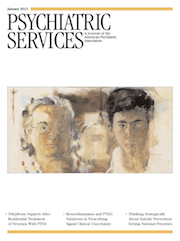The LORS-Enabled Dialogue: A Collaborative Intervention to Promote Recovery From Psychotic Disorders
Abstract
Objective
This study examined the effectiveness of the LORS-Enabled Dialogue (LED) in reducing the discrepancy between clinicians’ and patients’ ratings of the severity of symptoms of psychotic disorders, improving adherence to medication, and improving functioning.
Methods
The LED intervention addresses the discrepancy between a clinician’s severity rating of 13 symptoms measured by the Levels of Recovery From Psychotic Disorders Scale (LORS-clinician) and a patient’s severity rating (LORS-patient). A discrepancy in ratings (LORS-discrepancy), which is conceptualized as a patient’s lack of awareness of his or her symptoms, is used by the clinician as the focus of a brief motivational interviewing technique, the LED, to enhance recovery. Ninety adult inpatients or outpatients with psychotic disorders were randomly assigned to the LED intervention (N=50) or a control group (N=40). They were assessed on measures of symptom awareness (LORS-discrepancy), psychopathology (LORS-clinician, LORS-patient, and the Positive and Negative Syndrome Scale [PANSS]), adherence to medication (Kemp Compliance Tool), and functioning at baseline and at four postbaseline monthly assessments. The LED intervention was provided weekly for inpatients and monthly for outpatients.
Results
Among LED intervention participants, a decrease in psychopathology, as measured by the PANSS and LORS-clinician scores, and an improvement in functioning were noted, along with a decrease in LORS-discrepancy scores.
Conclusions
The LED intervention appears to be an efficient and effective treatment to reduce the severity of psychotic symptoms and improve functioning among persons with psychotic disorders. Further study of this intervention in various populations and clinical settings is needed.



